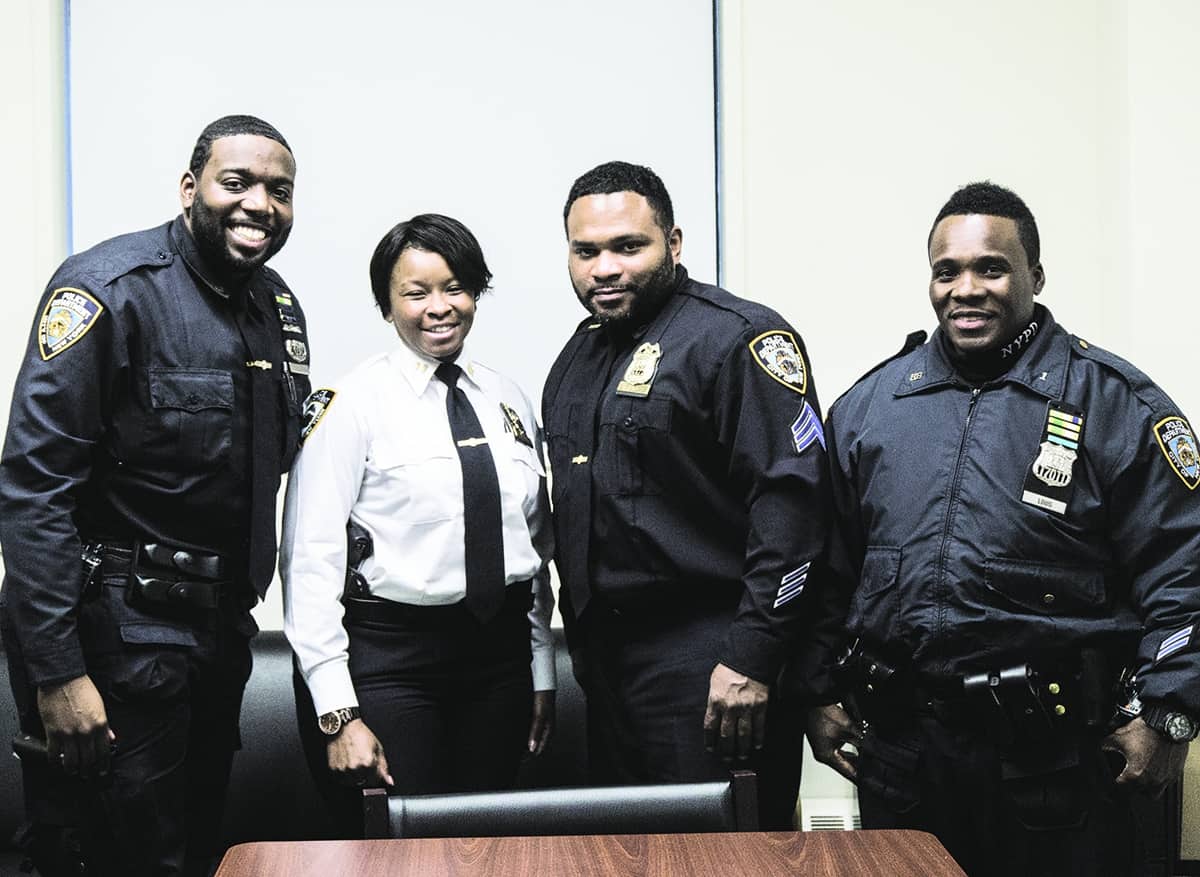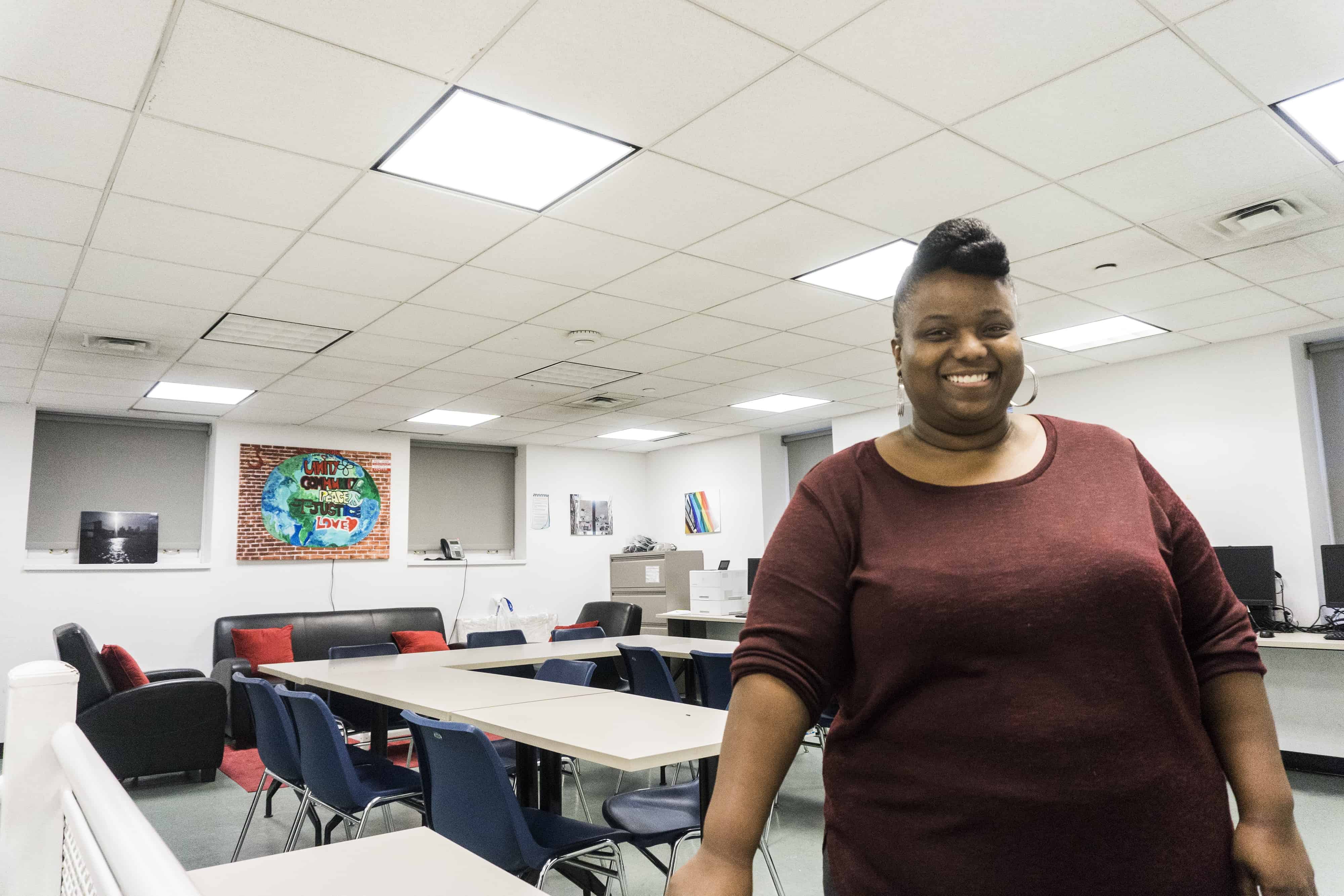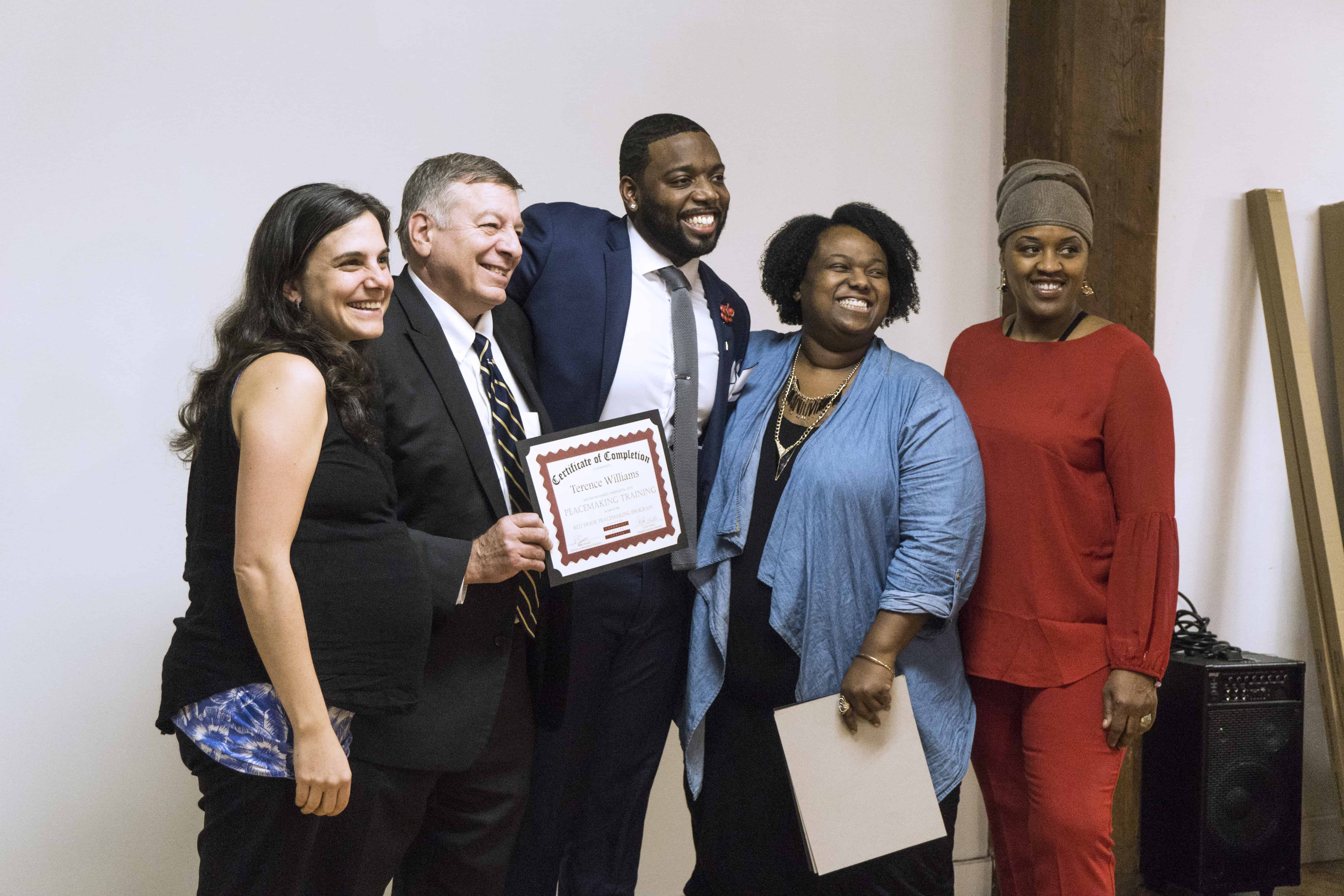
Terence Williams grew up in East New York, Brooklyn. Five years ago, Williams joined the New York Police Department, and on December 8 Officer Williams will graduate from the Red Hook Justice Center’s Peacemaking program.
The Peacemaking program adapts Native American conflict resolution strategies to New York City court cases within the Justice Center’s catchment area – police precincts 72, 76, and 78. It is the first such program in the country, and Officer Williams is among the first police officers to receive the training.
“We like Peacemaking because we’re not looked at solely as police officers. We’re looked at as human beings,” said Officer Williams during a November interview. “We want to do Peacemaking because we believe that it will be an alternative way to solve issues within the community – as opposed to doing things the traditional way, where if you do something wrong, we take you to jail. Maybe you can talk it out, let’s try that first.”
Amanda Berman is the Project Director at the Red HookJustice Center (RHJC). Berman started her career as a public defender in the Bronx, but gradually moved away from direct practice towards exploring alternatives to incarceration and reform of the criminal justice system. She came to the RHJC in 2015, and is excited about the officers’ engagement in Peacemaking.
“They’ll have more tools and options available than just ‘arrest or walk away,’” said Berman. “They’ve been a great resource for us but we are also providing a resource for them.”
Building Familiarity
This year saw an extensive expansion of community policing efforts by Mayor Bill de Blasio. The Neighborhood Coordination Officer (NCO) program was first rolled out in May 2015, and has been spreading across city precincts ever since. The program designates officers specifically for community policing. By engaging in neighborhood meetings, events, and programs, the NYPD hopes to be proactive in crime prevention as well as build bridges at a time when many communities feel alienated by the force.
“This is a crime-fighting model that is improving neighborhoods, incrementally on a small scale, block by block,” said then-Chief of Department, now Police Commissioner James P. O’Neill in an August press release announcing the expansion. “It’s all about our communities personally knowing their local cops, and trusting those cops to help them and their neighbors lead better lives. This is happening in a respectful and compassionate way, every day, all over New York – and it’s making the whole city safer.”
One place where the NCO program has made big waves is Police Service Area 1 (PSA1), which is responsible for policing the 19 NYCHA developments in South Brooklyn.
“The NCO program has been significant in helping us drive down crime,” Captain Neteis Gilbert, PSA1’s Commanding Officer, said in an interview with the Star-Revue. “It’s a universal program that helps people whether they’re a victim or a perpetrator, and just getting through daily life.”
Before receiving command of PSA1 in March, Captain Gilbert was an Executive Officer at Precinct 105 in Queens. She’s risen steadily through the ranks at a variety of ranks and assignments since 2000, when she joined NYPD. She said that for her, building relationships between the police and the community is essential.
“It’s one of my fundamentals,” said Gilbert. “In order to effectively address crime, you need the community. You have to listen, you have to understand what their issues and concerns are.”
There are 180 police officers under Gilbert’s command in PSA1. Most of them are organized into platoons, which might patrol a NYCHA development or be dispatched from their station house, reacting in relatively unknown territory to calls from relatively anonymous community members.
PSA1’s eight NCO’s, by contrast, “get the opportunity to be proactive, and actually see the results of it, and know that they’re helping,” said Gilbert. NCO’s attend Tenant Association meetings, give out their cell phone numbers, give presentations about domestic violence or bullying, and attend community events. They focus on crime prevention as well as simply becoming familiar with the communities in which they serve.
“It’s not like we’re seeing you one time, we’re seeing you probably every other day, or every day. You have that number, if your niece, nephew, grandchild or child needs a conversation about school, or bullying, or anything, we’re there.”
The eight NCO’s under Captain Gilbert’s command are spread across South Brooklyn’s housing projects. There are four in Coney Island, two in Canarsie, and two in Red Hook and Gowanus. These last two are based out of PSA1’s satellite location at 80 Dwight Street.
Gilbert anticipates assigning two additional NCO’s to Red Hook after the holidays and is eager to augment the program generally, but wants to focus on quality rather than quantity.
“There’s a significant screening process. They have to show a genuine interest, because it can be very demanding,” said Gilbert. “The program is only as effective as the community’s relationship with our NCO’s. If the community doesn’t buy into it, it’s not going to work.”
Officer Williams is one of Red Hook’s NCO’s.
“I always said to myself, as long as I’m going to be a police officer, I want to do something community based,” said Williams. “I thought about Community Affairs, but ever since they came out with the NCO program, it’s like Community Affairs on steroids. You get to and reach out to people in a way that I’ve never seen.”
“The NCO program has played a really important role,” said Amanda Berman of the Justice Center. “Their job is to get out into the community, and to get to know people, and to figure out how they can start building those relationships.”
In addition to their other duties, Red Hook’s NCO’s often participate in community events such as basketball games with local youth and Bridging the Gap, a series of events by the Red Hook Justice Center designed to give police officers and youth a safe space to interact and get to know each other on a human level.
25 youths and five police officers attended the first Bridging the Gap program in July. The second was attended by 40 youths and 15 officers.
“No one knew going into that first one whether people were just going to sit there in silence or whether people were going to feel comfortable talking,” said Berman. “They did. There was so much to say that it was hard to even wrap up – there was such a need and such a thirst for this kind of conversation that it could have gone on for hours and hours.”
It was in this spirit that Officer Williams and three other NCO’s enrolled in the Justice Center’s highly acclaimed three-month long Peacemaking program.
The Big Picture

The Justice Center opened in 2000. Galvanized in part by the violent death of beloved Principal Patrick F. Daly in 1992, the Red Hook community was seeking a radical shift in its dealings with crime and law enforcement.
“The death of Patrick Daly came at a time when the violence, and the crime, and the crack epidemic and all of those issues were really coming to a head in Red Hook,” said Berman. “They reimagined the role of a court, and the idea was to create a place that was really a community center and a court folded into one.”
RHJC builds that trust by providing access to social workers, addiction and mental health professionals, and classes. More significantly, important stakeholders such as the District Attorney’s office, the Defense Attorney, and RHJC’s Judge Alex Calabrese all take the input of these service providers seriously.
“Rather than addressing an immediate offense with that tunnel vision without looking at that big picture, we take a more holistic perspective at what is bringing this person through our doors,” said Berman. “The idea was to try to think about how we can solve community problems by engaging with the community, and how the justice system can play a different role in people’s lives, where it becomes sort of a partner with the community.”
All misdemeanors and most low-level felonies go through the RHJC, as well as summonses and quality of life tickets such as public urination. Before a defendant sees a judge, they can have access to a wide array of evaluations by RHJC staff.
The staff may then make a recommendation to the District Attorney (DA) and Judge Calabrese, who decides the conditions of release, such as treatment. The DA can also reduce or dismiss a case once someone has fulfilled these steps, avoiding the need for a criminal record.
According to Berman, only about one percent of defendants arraigned at the RHJC receive jail time as part of their sentence.
The court can also refer cases to the Peacemaking program, which began in 2012. Peacemaking is a ritualized approach to healing relationships within a community, which utilizes community members themselves. Participants sit in circles and use a talking piece to facilitate constructive discussion and mediate disputes.
“Rather than trying to hash out who was right and who was wrong about the incident itself, the bigger discussion is about how do we heal, how do we move forward, and how do we do that collectively and come to a consensus,” said Berman. It is a revolutionary alternative to conventional practice, especially since Peacemaking sessions are confidential and include no formal legal actors.
“The amazing thing about this is that the district attorneys are saying that we, the community, can take this case,” said Coleta Walker, RHJC’s Peacemaking Program Coordinator. “Once they give us the case, everything is confidential. They know nothing.”
Although many indigenous cultures use similar techniques, Red Hook’s program is modeled from Navajo practice. In traditional peacemaking, participants sing, drum, and purify the space by burning herbs. Instead, Red Hook’s Peacemakers may open and close a session with a moment of silence, deep breathing, or a poem.
“We had to take [Navajo] principles and the way that they do things and kind of tweak it for Brooklyn and Red Hook,” said Walker. “We tried to cater it for people with different cultures and different backgrounds.”
Once receiving the blessing of tribal leaders to adapt the program, Walker and others at the Center for Court innovation (which administers RHJC’s services) issued a call for community activists who wanted to volunteer for learning this process. They attended community board meetings, precinct meetings, and other local events. The first class was 13 people.
Cases can range from graffiti to shoplifting to noise complaints to assault, and referrals come not only from the court but from NYCHA managers, community boards, schools, and probation officers eager to resolve their client populations’ tensions before they enter the formal justice system. Walker has received 120 referrals so far this year, around 50 of which have completed the process.
Neighbors Helping Neighbors
After doing an intake, Walker references her roster of trained local Peacemakers to select those with relevant experiences and backgrounds. For a shoplifting or graffiti case, she might choose a business owner; for a resisting arrest case, she might choose a retired police officer; for a neighborly dispute, she is likely to choose someone like Wally Bazemore, an active community member with deep roots in Red Hook.
“I was raised in Red Hook, so I’m going to bring some of the Hook to the table,” said Bazemore, who has lived in the neighborhood on and off for 60 years. “Most of these people that I deal with in Red Hook, if I don’t know them, I know their grandparents.”
As a sort of tribal elder, Bazemore can probe his extensive knowledge of the community for insights about how to reach reticent participants.
“I might say something in reference to their parents,” said Bazemore. “We tell stories about our shortcomings, because nobody’s perfect, just to get them to open up, and let them know that we’re not here to pass judgement, just to get some clarity on the situation and bring some peace to the situation.”
According to Berman, the most successful cases are those between neighbors or family members – conflicts in which the parties have an interest in investing in their long-term relationship.
“If two neighbors have been disputing over noise complaints, or other issues, you’re bringing together not just those neighbors but maybe their family members or maybe other neighbors,” said Berman. The conventional process could involve one of the two parties getting an order of protection against the other, rendering them more divided than ever.
”Oftentimes these are friends, neighbors, or family members,” Berman continued. “When you tell them they can’t talk to one another, and they can’t be near one another, then you’re literally breaking these communities apart.”
After intake and a prepping session, the parties break bread together and sit down to talk out their differences in the company of the Peacemakers. Only one person in the circle may speak at a time. After one or many sessions, the group agrees on healing steps. Bazemore remembers his first case, in which a woman was caught shoplifting diapers from Target.
“She didn’t have family in this city, so she was living by herself with a child and a random boyfriend, and she had to take measures in her own hands,” remembered Bazemore. “Eventually she opened up. We had her call her mother and reestablish a relationship, and we had her send a letter to Target apologizing.”
Another case involved adult siblings who lived together and had been fighting for years. Healing steps in that instance involved the brother agreeing to wash dishes on certain days and the sister replacing the iPad she had thrown out their window in frustration. Cases involving disputes between parents and their teenagers may involve family outings.
A Good Rapport
Up until this point, Williams and his colleagues (Officers Louis, Trim, and Centeno) have only interacted with the Peacemaking program through referrals.
“Let’s say there’s a dispute between mother and daughter,” said Williams. “We’ll hear about it, we’ll do a check-up on the family and make sure they’re okay, we’ll listen to the story. We’ll interview the mom, interview the daughter, and we’ll say ‘you know what? This could probably be addressed in Peacemaking.’”
But starting next week, Officer Williams and the other graduating NCO’s will actually be called upon to participate in cases as trained Peacemakers. It’s an unprecedented step towards deepening community relations, putting police officers and those they serve together in a setting where everyone will feel vulnerable and, hopefully, secure.
All involved are eager for the experiment.
“They’re bringing a perspective that no one else in the group has,” said Berman about the NCO’s. “It’s giving the community members who are training alongside them a unique window into who these officers are and how they see their roles.”
Captain Gilbert is manifestly proud of her officers, and glad for the new communication skills they have gained.
“With the Peacemakers, it’s one of those situations where everyone is treated equally around the table, and you get heard, which often doesn’t happen,” said Gilbert. “We’ve heard nothing but positive things when we go to the community meetings and what have you.”
“When we come to sessions, we don’t come in uniform, we come dressed normally, just so it doesn’t intimidate anyone, and to show everyone that we’re on an equal playing field,” said Williams. “Those are the things that we look forward to. Showing everyone that we’re only humans, we’re all equal, there’s no power imbalance, there’s no pendulum, everyone’s the same.”










3 Comments
This sounds like a wonderful program, I look forward to NYPD working with the community to achieve a common goal. Just like Police Officer Williams stated they are human beings at the end of the day. The community needs to be able to work with the Officers and see that they’re there to protect and assist and not there to hurt anyone. Having this open line of communication and support should help with bridging the gap.
Pingback: NYPD Officers Graduate from Red Hook Justice Center’s Peacemaking Program | NYPD News
Cool…
http://nypdnews.com/2016/12/nypd-officers-graduate-from-red-hook-justice-centers-peacemaking-program/